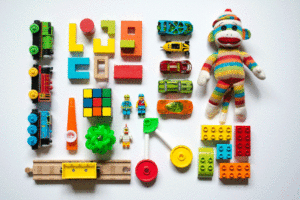The holiday season is a time for many of us to enjoy all the excitement that comes with selecting toys and presenting them to the little ones on our gift list. However, being drawn in by bright, shiny packaging and all the toy’s bells and whistles without considering the potential hazards of that item could lead to disaster.
Toy-related injuries send more than 26,000 children to the emergency room every year. These injuries include lacerations, asphyxiation, burns, poisoning, and more.
Do you know how to tell the difference between safe toys and those that are considered high-risk? The following guidelines can help you distinguish between the “naughty” and the “nice” on store shelves:

Choose the Right Toy for the Child’s Age
Most commercial toy packaging includes a suggested age range for that item. This information is helpful in determining if the toy suits the child’s level of development, if the child will be able to understand how to properly use the toy, and if there are any age-specific dangers associated with the toy such as small parts that could pose a risk of choking.
If you are shopping for a toy for a young child, but find something without a suggested age for the recipient, you should check the toy and avoid anything with loose parts, sharp edges, possible paint toxicity, and parts smaller than the diameter of a paper towel tube that could detach and become a choking hazard.
Remember That Bigger is Better
When in doubt, go for large toys with large parts. Not only do small parts pose a choking hazard to babies and toddlers who put items into their mouths as a way of exploring their environment, but small parts can also be dangerous for older children if they are stepped or fallen on. Additionally, larger toys are great for developing muscle control and coordination while smaller toys and small parts can cause strains to the growing nerves and connective tissue in a child’s hands.
Be Aware of Flying Parts and Projectile Perils
Toys that fly or that have projectile parts, while very alluring to children and adults alike, can cause serious eye injuries and may be potential choking hazards. These types of toys are advised only for children of the age recommended on the item’s packaging, and even then they should be used with proper eye protection, preferably while under the supervision of an adult.
Think Twice About Magnets and Cords
Magnetic toys can be a fun learning experience for older children, but you should reconsider them if you are shopping for a young child or toddler. While the toy itself may be large enough that it poses little risk when intact, small magnets can detach and then be swallowed by curious tykes. Magnets can tear delicate gastrointestinal tissue if taken internally, and many cases of swallowed magnets have required surgical removal.
Cords and strings pose a risk of strangulation as well as tissue damage in the limbs if they are wrapped or tied tightly enough to obstruct blood flow. Though it is more common to think of babies and toddlers when considering strangulation risks, older children are vulnerable to those risks as well.
Check the Noise Level
According to data collected by the U.S. Department of Health and Human Services, the rate of hearing damage and hearing loss in children has risen 31% since 1990. They attribute personal listening devices and loud toys with that startling climb.
The Sight & Hearing Association recommends simply listening to a toy as the best way to determine its noise level. If the toy is too loud for you to listen to comfortably, then it is too loud for a child. If you are shopping online and are unable to try out an item’s volume for yourself, you can refer to the Sight & Hearing Association’s Noisy Toys study for products to avoid.
Educate Yourself About Recalls
If you have your eye on a specific toy for a child on your list, a quick internet search is usually all that’s required to find out if that item has been recalled for safety concerns.
Another valuable resource to holiday shoppers is the annual “Most Dangerous Toys” list compiled by consumer safety group World Against Toys Causing Harm (WATCH). Items named on the 2017 list include:
- Hallmark “Itty Bittys” Baby Stacking Toy. Fabric hats and bows can detach and pose a choking hazard.
- Pull Along Polly. This toy’s 19-inch long cord presents a strangulation hazard. Industry safety standards for toys targeted to this age group require cords to be less than 12 inches long.
- Wonder Woman Battle Action Sword. The rigid sword may cause blunt trauma or eye injuries.
- Hand Fidgetz Spinners. These popular toys have been recalled due to dangerously-high levels of lead.
- Spider-Man Spider-Drone Official Movie Edition. This toy launches a drone into the air using rotating rotor blades. It was recalled due to the high risk of eye injuries.
- Nerf Zombie Strike Deadbolt Crossbow. WATCH claims the force with which the arrows are launched can cause serious eye or facial injuries.
- Slackers Slackline Classic Series Kit. Marketed to “children of all ages”, this toy poses serious risk of strangulation and fall-related injuries.
- Oval Xylophone. A small drumstick handle on this instrument can block a child’s airway.
- Jetts Heel Wheels. These sparking wheels were flagged by WATCH due to the risk of burns.
- Brianna Baby Doll. This doll was recalled due to small removable parts that could be choking hazards.
Buying safe toys can be easy when you take your time, examine a toy’s parts, and ensure that its features are appropriate for the age of the child you’re shopping for. Educate yourself, read consumer reviews and complaints, and remember to keep in mind these shopping guidelines for fun and safe gift-giving this holiday season.




